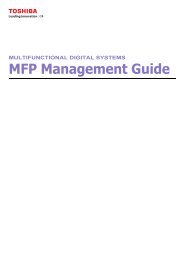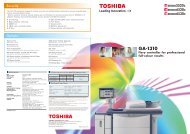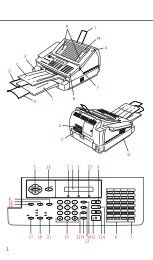11-12 GA-1120 Color Management - Toshiba
11-12 GA-1120 Color Management - Toshiba
11-12 GA-1120 Color Management - Toshiba
You also want an ePaper? Increase the reach of your titles
YUMPU automatically turns print PDFs into web optimized ePapers that Google loves.
1-10 <strong>GA</strong>-<strong>11</strong>20 <strong>Color</strong> <strong>Management</strong><br />
The CMYK Simulation Profile setting you specify depends on the press standard for<br />
which the CMYK data was separated.<br />
• For images that were separated using a custom separation (such as a separation<br />
produced with an ICC profile), choose the corresponding profile on the <strong>GA</strong>-<strong>11</strong>20<br />
with the CMYK Simulation Profile setting.<br />
• For images that were separated for SWOP, choose SWOP as the CMYK Simulation<br />
Profile setting.<br />
NOTE: To properly simulate a printed image that was separated through the use of<br />
an ICC profile, the same profile must be present on the <strong>GA</strong>-<strong>11</strong>20. For more<br />
information about downloading ICC profiles to the <strong>GA</strong>-<strong>11</strong>20, see “Downloading<br />
profiles” on page 3-4.<br />
The <strong>Color</strong>Wise Off settings send unconverted CMYK data directly to one of the two<br />
uncalibrated modes available on the copier. <strong>Color</strong>Wise Off-Gamma produces a density<br />
curve similar to that of an offset printer. <strong>Color</strong>Wise Off-Linear yields a straight line<br />
density curve. The <strong>Color</strong>Wise Off settings are designed for specific applications only.<br />
For example, Calibrator (one of the <strong>Color</strong>Wise Pro Tools) prints its patch pages using<br />
the Gamma mode. Avoid using uncalibrated modes for generic printing because other<br />
color settings and printing overrides may be incompatible.<br />
CMYK Simulation Method<br />
The CMYK Simulation Method lets you define your preferred CMYK-to-CMYK<br />
conversion technique.<br />
• Quick applies one-dimensional transfer curves to adjust output densities in the cyan,<br />
magenta, yellow, and black channels. This technique leads to pleasant color output<br />
from your copier because pure primary colors are not “contaminated” by other<br />
colorants. While it is the fastest simulation method and perfect for drafts, avoid<br />
using it for final documents that will be used as press proofs. Other techniques offer<br />
more color simulation accuracy, which is expected by proofing applications.<br />
• Full (Source GCR) provides a complete and accurate simulation based on colorimetric<br />
transformations. Hues are preserved, even for primary colors. The Gray Component<br />
Replacement (GCR) level that was specified in the original (source) document is also<br />
preserved. Full (Source GCR) is therefore an excellent simulation technique for the<br />
highest quality press proofing applications.






